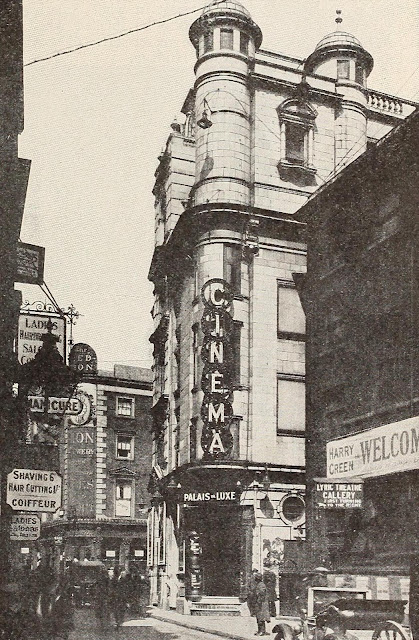Soho’s Silent Cinemas.
Because of his family’s health problems, the diarist George
Thomas, whose tenement rooms overlooked Berwick Street Market, didn’t leave the house
much. But, still, he managed to keep up with the latest film news from
magazines and conversations with friends. Finally, in May 1930, he recorded a
personal ‘high-spot’: a trip to see his first ‘talkie’, The Broadway Melody, probably at the nearby Empire Theatre,
Leicester Square, which had recently been converted into MGM’s flagship London
cinema. George was hooked. ‘From now on’, he wrote, ‘I am an ardent
“talkie-fan,” in the sense that I will never refuse the chance of going again.’
The legacy of the West End’s gigantic movie palaces, most of
them opened in the 1920s and 1930s, is still around us. As well as the Empire,
the nearby Odeon Leicester Square and the recently closed Odeon West End have
provided a link to a time when cinema was a large part of the glamour of a trip
‘Up West’. Less visible are the traces of the West End’s earlier film venues:
the places that first introduced George Thomas’s fellow Soho-ites to the
movies, and that helped make room for cinema in the busy West End entertainment
scene.
 |
| Cinema and the West End, 1906-1930. |
 |
| The National Bioscope. |
The West End hosted film shows from the earliest days. In
February 1896, a few months after the initial screenings in Paris, the Lumière
brothers’ new Cinématographe device was given its first commercial
demonstration anywhere in the UK at the Polytechnic Institute on Regent Street.
Very quickly, the Cinématographe and other rival moving-picture technologies made
their way onto the bills of the West End’s variety theatres, where they stayed
(in some form or other) for the next two decades. Dedicated film venues took
longer to emerge, although there were early experiments. In May 1896, the film
pioneer Birt Acres chose ‘a pleasant little hall in Piccadilly Circus’ (at 2
Piccadilly Mansions) to open his short-lived Kineoptikon, arguably the West
End’s first full-time cinema. More lasting was the venue opened in 1906 by
Hale’s Tours of the World at 165 Oxford Street, which used films and special
sound effects to give its visitors virtual trips to far-off locations inside a
replica train carriage.
By the time Hale’s Tours closed in 1910, there were already
several other cinemas in the West End. Soho proper got its first recorded
cinema in 1908, when the French-born chemist Felix Haté opened the ElectricCinema Theatre at 6 Ingestre Place (later re-named the Jardin de Paris). Like
many early cinemas, the Electric was a conversion, in this case from a
ground-floor residence and an adjoining stable, which backed onto the narrow
William and Mary Yard. This small cinema was popular with locals, especially
working-class English, French and Jewish youngsters, who were charged rock-bottom
prices to watch short programmes of films, accompanied by an electric piano.
Also popular with Soho’s children was the National Bioscope at 20 Frith Street
(a building best known for once being occupied by Mozart), which was opened by
an Italian family in 1910.
Both these side-street cinemas closed before the end of
World War I, unable to deal with the increasingly strict safety regulations
imposed by the London Council Council, and also struggling in the face of
competition from a new breed of purpose-built ‘picture palaces’. An early
example was the Piccadilly Circus Cinematograph Theatre, at 43-44 Great
Windmill Street, built on the site of a former motor garage. Backed by the
cinema magnate Montagu Pyke, it boasted such genteel amenities as a ‘vestibule
lounge’, decorated (according to one trade paper) to suggest ‘a drawing-room at
a royal palace or ducal mansion’. Even more luxurious was the 700-seat West EndCinema (later the Rialto, and now the Grosvenor Casino), which opened in March
1913 at 3-4 Coventry Street, and soon became a favourite spot for film
premieres and other gala events.
 |
| Palais de Luxe, Great Windmill St. Courtesy of Media History Digital Library. |
The wartime ban on luxury building meant that no new cinemas
were constructed in the West End until well into the 1920s. When building re-started,
the trend was for even larger ‘super cinemas’, like the Astoria on CharingCross Road, opened in 1927. But small, more specialist film venues also found a
home in the neighbourhood. At the very end of the 1920s, the Avenue Pavilion on
Shaftesbury Avenue (on the spot of what is now the Curzon Soho) and the Palaisde Luxe at 17-18 Great Windmill Street (before it was the Windmill Theatre)
were pioneers of the repertory cinema movement in London. Their eclectic programmes
of ‘classic’ and rare films from Hollywood, Britain and around Europe brought
people into Soho from across the city, and allowed the era of silent films in
the West End to last a little longer.
With thanks to Dr Chris O'Rourke and Media History Digital Library.
About the author: Dr Chris O’Rourke teaches Film Studies at
University College London. More of his research into the West End’s early
cinema history can be found on the website London’s Silent Cinemas
(www.londonssilentcinemas.com).


No comments:
Post a Comment